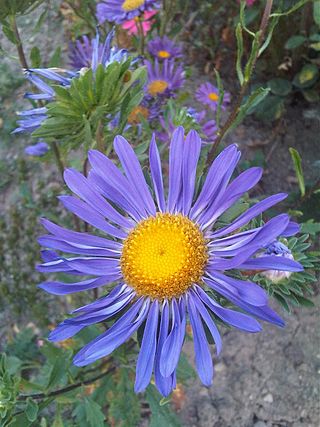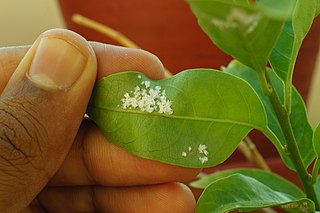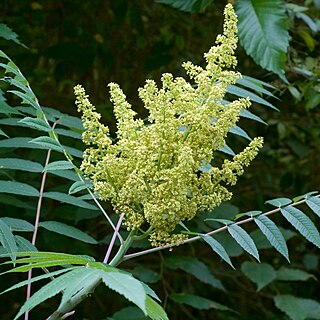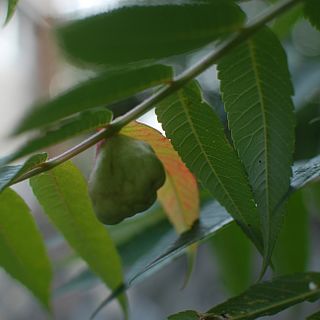
Sumac, also spelled sumach, is any of about 35 species of flowering plants in the genus Rhus and related genera in the cashew family (Anacardiaceae). Sumacs grow in subtropical and temperate regions throughout every continent except Antarctica and South America. Sumac is used as a spice, as a dye, and in medicine.

Aphids are small sap-sucking insects and members of the superfamily Aphidoidea. Common names include greenfly and blackfly, although individuals within a species can vary widely in color. The group includes the fluffy white woolly aphids. A typical life cycle involves flightless females giving live birth to female nymphs—who may also be already pregnant, an adaptation scientists call telescoping generations—without the involvement of males. Maturing rapidly, females breed profusely so that the number of these insects multiplies quickly. Winged females may develop later in the season, allowing the insects to colonize new plants. In temperate regions, a phase of sexual reproduction occurs in the autumn, with the insects often overwintering as eggs.
Galls or cecidia are a kind of swelling growth on the external tissues of plants. Plant galls are abnormal outgrowths of plant tissues, similar to benign tumors or warts in animals. They can be caused by various parasites, from viruses, fungi and bacteria, to other plants, insects and mites. Plant galls are often highly organized structures so that the cause of the gall can often be determined without the actual agent being identified. This applies particularly to insect and mite plant galls. The study of plant galls is known as cecidology.

Callistephus is a monotypic genus of flowering plants in the aster family, Asteraceae, containing the single species Callistephus chinensis. Its common names include China aster and annual aster. It is native to China and Korea. and it is cultivated worldwide as an ornamental plant in cottage gardens and as a cut flower.

The Aphididae are a very large insect family in the aphid superfamily (Aphidoidea), of the order Hemiptera. These insects suck the sap from plant leaves. Several thousand species are placed in this family, many of which are considered plant/crop pests. They are the family of insects containing most plant virus vectors with the green peach aphid being one of the most prevalent and indiscriminate carriers.

Woolly aphids are sap-sucking insects that produce a filamentous waxy white covering which resembles cotton or wool. The adults are winged and move to new locations where they lay egg masses. The nymphs often form large cottony masses on twigs, for protection from predators.

Rhus typhina, the staghorn sumac, is a species of flowering plant in the family Anacardiaceae, native to eastern North America. It is primarily found in southeastern Canada, the northeastern and midwestern United States, and the Appalachian Mountains, but it is widely cultivated as an ornamental throughout the temperate world. It is an invasive species in some parts of the world.
The gall adelgid is an adelgid species that produces galls in spruce trees. They infect the new buds of native spruce trees in the foothills of the Rocky Mountains in the spring. They also attack blue spruce to a lesser degree. The insects complete two generations within the year. They require two different trees for its life cycle, the second being the Rocky Mountain Douglas-fir. They may also attack Sitka, Engelmann, or white spruce. The many different species of adelgids produce different galls on different spruce species.

The Adelgidae are a small family of the Hemiptera closely related to the aphids, and often included in the Aphidoidea with the Phylloxeridae or placed within the superfamily Phylloxeroidea as a sister of the Aphidoidea within the infraorder Aphidomorpha. The family is composed of species associated with pine, spruce, or other conifers, known respectively as "pine aphids" or "spruce aphids". This family includes the former family Chermesidae, or "Chermidae", the name of which was declared invalid by the ICZN in 1955. There is still considerable debate as to the number of genera within the family, and the classification is still unstable and inconsistent among competing authors.

Rhus glabra, the smooth sumac, is a species of sumac in the family Anacardiaceae, native to North America, from southern Quebec west to southern British Columbia in Canada, and south to northern Florida and Arizona in the United States and Tamaulipas in northeastern Mexico.

Rhus aromatica, the fragrant sumac, is a deciduous shrub in the family Anacardiaceae native to North America. It is found in southern Canada and nearly all of the lower 48 states except peninsular Florida.
M. chinensis may refer to:

Rhus chinensis, the Chinese sumac or nutgall tree, is a deciduous shrub or small tree in the genus Rhus. Growing to 6 m (20 ft) tall, it has downy shoots and leaves comprising several leaflets. These turn red in autumn before falling.

The pineapple gall adelgid is a species of conifer-feeding insect that forms pineapple-shaped plant galls on its host species, commonly Norway and Sitka spruce. The adelgids are pear-shaped, soft-bodied green insects with long antennae, closely related to the aphid. Adelges lays up to one hundred eggs at a time, one on each needle. Adelges abietis is one of the most common species; synonyms are A. gallarum-abietis, Chermes abietis and Sacciphantes abietis.

Pemphigus spyrothecae, or the poplar spiral gall aphid, is a social insect which exhibits apparent altruistic behaviors. The aphids form galls and act as colony defenders, at times sacrificing their own lives to do so. It has been shown that colony defense is more likely in habitats that are difficult to obtain and can hold a large number of individuals. These gall locations are crucial because plants have a short window in which a gall can be produced. Thus, it is important for there to be a defense system that enables the aphids to retain their galls. The need for defense arises when the gall is opened up to allow winged aphid migrants to leave and to release any waste. The process of repairing the holes can take up to 10 days; during this time, the gall is susceptible to intruding predators.

Phylloxeridae is a small family of plant-parasitic hemipterans closely related to aphids with only 75 described species. This group comprises two subfamilies and 11 genera with one that is fossil. The genus type is Phylloxera. The Phylloxeridae species are usually called phylloxerans or phylloxerids.

Melaphis rhois is an aphid species first identified by Asa Fitch in 1866. Known as the staghorn sumac aphid, it is the only species in the genus Melaphis. It is a type of woolly aphid and one of the few aphids that induce the formation of galls.

Tetraneura is a genus of woolly and gall-making aphids in the family Aphididae. There are more than thirty described species in Tetraneura.

Nipponaphis hubeiensis is a species of aphid discovered in 2021 in China, making N. hubeniensis the third species discovered in China. The species on average is 1.25 mm in length.
Pipiza puella, the sumac gall pithead, is a species of syrphid fly observed in eastern and Central United States, Canada and Norway. Hoverflies can remain nearly motionless in flight. The adults are also known as flower flies for they are commonly found on flowers from which they get both energy-giving nectar and protein rich pollen. Larvae when known are aphid predators.















